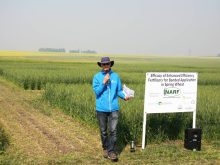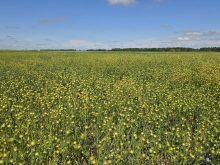Three cases of late blight have been confirmed in Manitoba but only one of those is in the commercial potato crop, said a provincial potato specialist.
“One is in what’s defined as the southern region… the area of Plum Coulee, Rosetown, Winkler, Carman… the southern production area,” said Tom Gonsalves of Manitoba Agriculture.
The other confirmed location is in Swan River, hundreds of kilometres northwest of Manitoba’s potato growing region.
“In a home garden there’s been a positive late blight on a potato and tomato,” said Gonsalves, who’s not sure if the same home garden is the location of both cases in Swan River.
Read Also

Fertilizer method’s link to emissions studied
A researcher says others studying greenhouse gas emissions aren’t considering how the loss of nitrogen into the atmosphere correlates with fertilizer application or if there is an impact to yield.
Late blight, which causes lesions on the leaves and stems of potato plants, was the cause of the infamous Irish famine. Spores of the disease flourish in wet conditions and can quickly spread.
Late blight was discovered in southern Manitoba in the third week of August, approximately the same time that the disease was detected in North Dakota.
“We have one find in Grand Forks County, which is in North Dakota, and we have one find along the North Dakota–South Dakota border,” said Chuck Gunnerson, president of the Northern Plains Potato Growers Association.
The discovery of late blight represents the first confirmed cases of the disease in the Dakotas and Minnesota in nearly a decade, Gunnerson said.
Late blight was detected in Manitoba last year, Gonsalves said, but it was found when potatoes were in storage.
Both Gonsalves and Gunnerson are pushing the message that there’s no need to panic, but potato producers must continue to check fields for late blight and spray their crop with fungicide on a five to seven day rotation.
In addition to continued vigilance, Manitoba Agriculture is asking producers to send suspect plants to the crops diagnostic lab at the University of Manitoba.

















